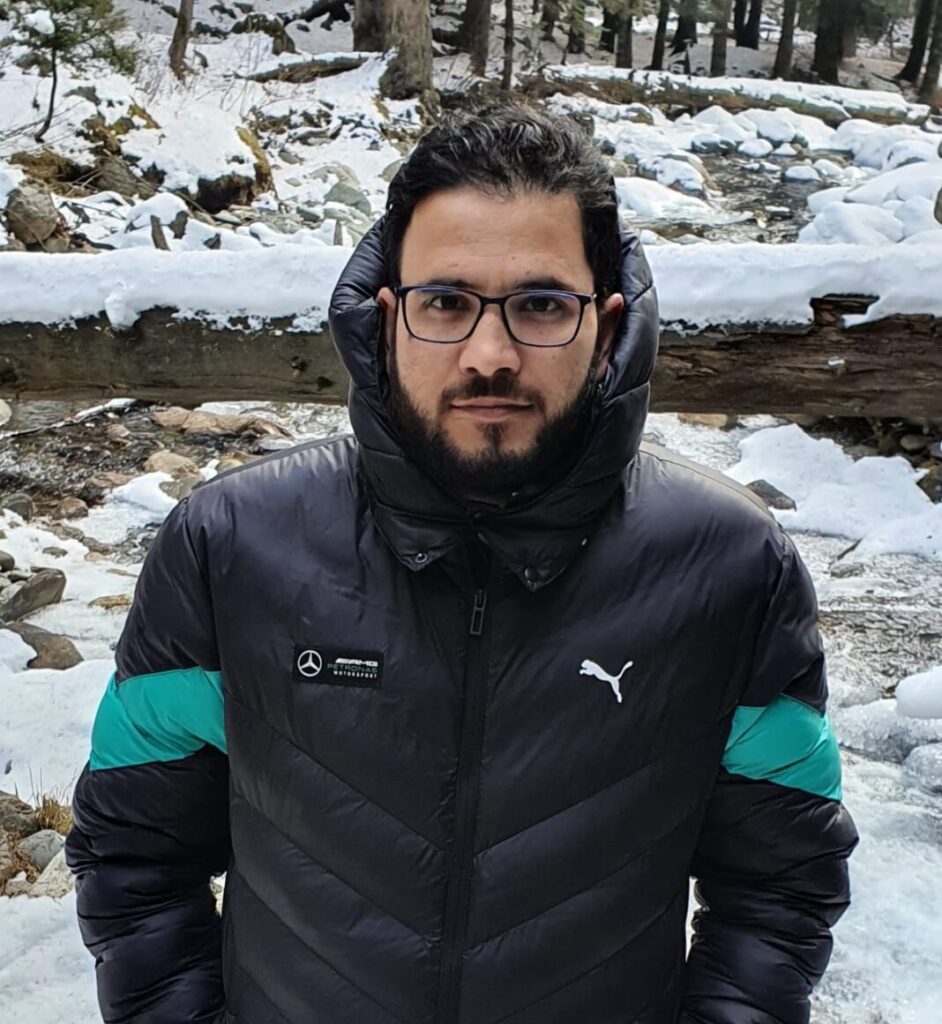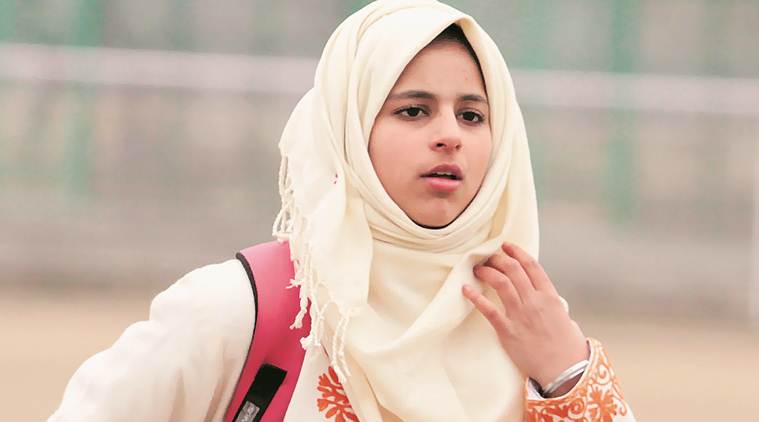INDIA / Thuwal, SAUDI ARABIA :

This is the sixth part of the series – `Scientist Says’ – where we bring for our readers the significant and commendable research works of young scientists in various fields.
Dr. Imtiyaz Ahmad Bhat started working as a researcher in the year 2013 with Prof. P.S Mukherjee lab, Inorganic and Physical Chemistry department, IISc Bangalore. He completed his Ph.D in 2018 and worked as a Research Associate in the same department. Currently, Dr. Imtiyaz is working as a post-doctoral fellow in King Abdullah University of Science and Technology (KAUST), Saudi Arabia. He shares his significant research works with Rashida Bakait of India Tomorrow. Here are the excerpts of the interview.
Q. To begin with, please explain in brief to our readers about `Supramolecular Chemistry’ and the research works associated with the subject.
Ans. Nature has inspired scientists to exploit the potency of weak non-covalent interactions to form complex functional Supramolecules, with wide range of applications, which led to the birth of a new field of chemistry called ‘Supramolecular chemistry’ i.e. chemistry ‘beyond molecule’. Supramolecules are large complex molecules formed upon aggregation of smaller constituent building blocks through non-covalent interactions by a process called ‘self-assembly’. ‘Self-assembly’ is a spontaneous process where components, either separated or linked, reversibly form complex ordered aggregates without any external direction. Supramolecular chemistry has emerged as a broad field and has given rise to vast number of diverse structures by using a variety of non-covalent intermolecular interactions.
Over the past two decades, various methodologies of co-ordination driven self-assembly for the rational design of polygons and 3D supramolecular including tetrahedra, cubes, octahedra, cuboctahedra, and others have been developed. Enzymes, which are nature’s molecular containers, possess molecular pockets capable of binding substrates through non-covalent interactions and catalyze many important enzymatic reactions. Over the last two decades, with the advent of co-ordination driven self-assembly, the focus has greatly shifted to exploiting weak metal–ligand coordination for the self-assembly of molecular containers from individual components. The simple yet dynamic nature of coordination driven self-assembly has led to the construction of various capsules and cages with nanometre-size cavities capable of various applications. The shape and size of inner cavity of the coordination cages, even those not possessing definite covalent interactions between the catalyst and substrate, play a paramount role in altering the reactivity and properties of the contained molecules.
The central theme of my doctoral research interest in IISc has been in the area of co-ordination driven supramolecular chemistry, arguably one of the hottest areas of chemical sciences. In my research work at IISc Bangalore, I was specifically engaged in developing novel coordination cages possessing confined cavity and demonstrate their applications in cavity directed catalysis and stimuli-responsive targeted drug delivery.
Besides this, my current research focus at King Abdullah University of Science and technology, Saudi Arabia as Post-doctoral fellow is to design and synthesize the Imine-based macrocycle which will act as Non Adaptive Crystal Systems (NACs) and will eventually be used for separation of hydrocarbon and their derivatives. These Imine based macrocycles offer plenty of merits, such as easy preparation, low cost, high recyclability, chemical resistance, and thermal stability and hence makes them ideal material for industrial application.
Q. What was the objective of your research?
Ans. The supramolecular coordination complexes are obtained by mixing soluble metals as acceptors and ligand precursors as donors which spontaneously form metal-ligand bonds to generate a single thermodynamically-favoured product. Over the past two decades, various methodologies of coordination driven self-assembly for the rational design of polygons and 3D supramolecules including tetrahedra, cubes, octahedra, cuboctahedra, and others have been developed. My aim was to examine the self-assembly of pyridine and pyrimidine based ligands with square planar Pd(II) and Pt(II) metal ions to get the water soluble supramolecular structures with intrinsic hydrophobic cavity. These supramolecules with intrinsic hydrophobic cavity have a potential to function like the naturally found catalysts i.e enzymes by mimicking the cavity driven enzymatic reactions.
Q. When did you begin and complete your research?
Ans. I started in 2013 as a PhD student in Prof. P. S. Mukherjee lab at IISc Bangalore. Currently. I am working as a post-doctoral fellow in King Abdullah University of Science and Technology (KAUST), Saudi Arabia.
Q. What were the new findings of your research?
Ans. I could successfully synthesize and characterize various water soluble supramolecular structures with different shapes like sphere in sphere, tubes, tetrahedron, molecular barrels etc. and sizes. The tetrahedral cage with confined space was used as supramolecular catalyst to promote the Michael Addition Reaction of Indole and various nitro-styrene derivatives in water. The hydrophobic cavity of water soluble barrel like structures was successfully utilized to encapsulate curcumin and increased its solubility, enhanced its stability against UV light and thus acted as a safe aqueous carrier of curcumin to HeLa cancer cells. Also, an unusual supramolecule with triangular orthobicupola geometry was obtained, which is the first example of its type reported so far. The confined pocket of this cage with unique structural topology has been successfully used for the catalytic intramolecular cycloaddition reaction of substrates containing less reactive alkyne dienophile.
Q. What was the conclusion of your research?
Ans. In conclusion, we could successfully synthesize and characterize a giant double layered spherical structure with 24 Pd (Palladium) ions and 24 Pyrimidine based ligands. The strategy used here for the synthesis of double-shell superstructure establishes new guidelines for the creation of novel complex architectures. To further explore Pyrimidine as donors, various ligands with Pyrimidine as donors were synthesized and their self-assembly with cis-blocked Pt acceptor has led to formation of tube and tetrahedral cage structures. The tetrahedral cage with confined space was used as supramolecular catalyst to promote the Michael addition reaction of indole and various nitro-styrene derivatives. We were able to synthesize and characterize a water soluble barrel and cylindrical assemblies.The hydrophobic cavity of water soluble barrel was successfully utilized to encapsulate curcumin and increased its solubility, enhanced its stability against UV light and thus acted as a safe aqueous carrier of curcumin to HeLa cancer cells. The cylindrical assembly obtained was found to adopt an unusual triangular Orthobicupola geometry, which is the first example of its type reported so far. The confined pocket of this cage with unique structural topology has been successfully used for the catalytic intramolecular cycloaddition reaction of substrates containing less reactive alkyne dienophile.
Q. What kind of challenges did you face?
Ans. Challenges and difficulties are the inherent part of the research and researchers have to find ways to overcome them and materialize their tasks. It was really a herculean task in characterizing these supramolecular structures. However, patience and positive attitude helped me to keep trying and I could finally characterize them well and obtained their crystal structures. As a beginner, I struggled with writing my results and presenting them in scientific journals.
Q. Any scholarships or awards for research?
Ans. My Research Associateship was extended for one more year in IISc for completing research within five years. In 2019 I received Irish research post-doctoral fellowship in Trinity College, Dublin
Q. How do you think your research would be beneficial to the society or industry?
Ans. The 3D metallo-supramolecular architectures with confined cavity have been exploited for many applications such as- guest encapsulation, catalysis and drug delivery etc. we were able to show that organic chemical reactions can be performed in water using these water soluble supramolecular structures. Barrel shaped molecules are highly promising which possess large open windows along with large confined cavity. Our approach provides one of the elegant and efficient methods to design such barrel shaped architectures and their use to perform the catalytic organic transformation in aqueous medium. A lot of effort is going on in the scientific field to design new such systems and utilize them for various applications. The importance of this field could be easily reflected from the 2016 Nobel Prize which was awarded for novel findings in supramolecular chemistry.
Q. How do you think your research can be carried forward?
Ans. The features of coordination driven self-assembly like high directionality, intermediate bond enthalpy and vast diversity of organic ligands make it unique over the other non-covalent self-assembly approaches. The coordination-driven self-assembly was initiated by Lehn and Sauvage and pioneered the field with the introduction of various architectures ranging from ladders, helicases, rings, knots, rotaxanes, catenanes, and several other architectures. Later on, other scientists have taken the field to newer heights by developing novel methodologies and approaches to design and synthesize various discrete metal-organic architectures of distinct shapes, sizes and functionalities. The breadth of coordination driven self-assembly has continuously increased with the introduction of numerous functional supramolecules each year and it keeps on growing with every passing day.
Q. Any new research you are working on now?
Ans. My current research focus at King Abdullah university of Science and technology, Saudi Arabia as Post-doctoral fellow is to design and synthesize the Imine based macrocycle which will act as Non Adaptive Crystal Systems (NACs) and will eventually be used for separation of hydrocarbon and their derivatives. These Imine based macrocycles offer plenty of merits, such as easy preparation, low cost, high recyclability, chemical resistance, and thermal stability and hence makes them ideal material for industrial application.
Q. Give few suggestions to budding scientists.
Ans. For those who have decided to take research as their career, I would like to suggest them that patience is the key and keep learning from the mistakes as this is how it works in research. As a researcher, update yourself with the current literature related to your field that will help you to give new directions to your ongoing projects. Time management is crucial. Plan your experiments in advance so that you are confident about tasks you will be performing. Wishing goodluck to all budding scientists.
source: http://www.indiatomorrow.net / India Tomorrow / Home> Education> Featured / by Rashida Bakait, India Tomorrow / April 28th, 2021









